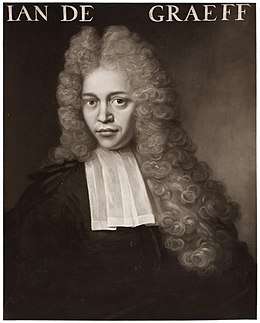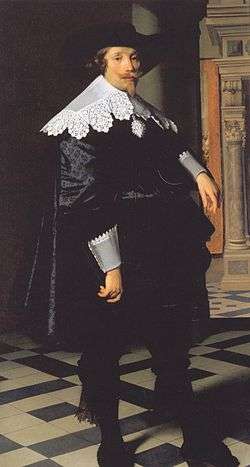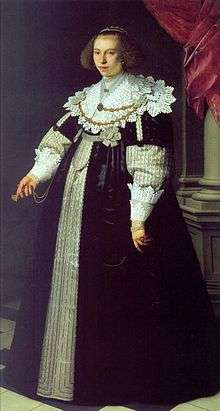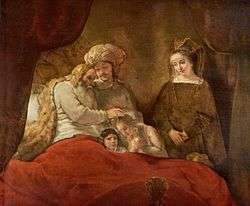Johan de Graeff
Johan de Graeff, also Jan de Graeff (29 October 1673 in Amsterdam – 12 April 1714) - Lord of the semisouverain Fief Zuid-Polsbroek and Lord of the castle Ilpenstein - was a member of the De Graeff - family from the Dutch Golden Age.

Life
He was the oldest son of Pieter de Graeff and Jacoba Bicker, his elder brother was Cornelis de Graeff II., Baron of Purmerland and Ilpendam, and De Graeffs younger sister Agneta de Graeff, who married to Jan Baptiste de Hochepied, lives in a City-Palace today called Kabinet der Koningin.
After his studies at the University of Leiden in the year 1699, he became an advisor and from 1709 to 1714 a member of the vroedschap of the City of Amsterdam.
De Graeff residence at the Herengracht in a house now called Tassenmuseum Hendrikje, at castle Ilpenstein and at Bronstee, a Countryhouse near Heemstede.
In the year 1709 Johan married Johanna Hooft, they had five children:
- Jacoba Adriana de Graeff (1710–1745), married to Mr. Jacob Jan de Blocq van Kuffeler
- Gerrit de Graeff I (1711–1752), married to Maria Elisabeth Sautijn and later with Elisabeth Lestevenon; Gerrit succeeded his as Lord of Zuid-Polsbroek.
- Alida Joanna de Graeff (1713–1757), married with Mr. François de Witt.
Johan de Graeff has a big art collection including paintings from Rembrandt van Rijn, Gerard Ter Borch and Jacob van Ruisdael. The collection know three very famous pictures, Catharina Hooft with her Nurse, painted by Frans Hals, Jacob Blessing the Sons of Joseph and Portrait of Andries de Graeff, both from Rembrandt.
Art collection
 Johan de Graeffs Grandmother Catharina Hooft as a child, by Frans Hals (1619)
Johan de Graeffs Grandmother Catharina Hooft as a child, by Frans Hals (1619) Cornelis de Graeff, painted by Nicolaes Eliaszoon Pickenoy, Gemäldegalerie, Berlin, (1636)
Cornelis de Graeff, painted by Nicolaes Eliaszoon Pickenoy, Gemäldegalerie, Berlin, (1636) Catharina Hooft - second wife of Cornelis de Graeff, painted by Nicolaes Eliasz. Pickenoy (1636)
Catharina Hooft - second wife of Cornelis de Graeff, painted by Nicolaes Eliasz. Pickenoy (1636) Andries de Graeff, painted by Rembrandt in 1639
Andries de Graeff, painted by Rembrandt in 1639 Jacob Blessing the Sons of Joseph by Rembrandt (Portrait of Petrus Scriverius, Wendela de Graeff and their sons) (Rembrandt, 1656)
Jacob Blessing the Sons of Joseph by Rembrandt (Portrait of Petrus Scriverius, Wendela de Graeff and their sons) (Rembrandt, 1656) Cornelis de Graeff at Soestdijk, painted by Jacob van Ruisdael (1656-1660)
Cornelis de Graeff at Soestdijk, painted by Jacob van Ruisdael (1656-1660) Portrait of Jacob de Graeff (1642-1690), painted by Gerard ter Borch (second half 17th century)
Portrait of Jacob de Graeff (1642-1690), painted by Gerard ter Borch (second half 17th century).png) Portrait of Cornelis HrR Ridder de Graeff (1650-1678), painted by Gerard Terborch (1673)
Portrait of Cornelis HrR Ridder de Graeff (1650-1678), painted by Gerard Terborch (1673)
Noble title
Johan de Graeff Born: 29 October 1673 Died: 12 April 1714 | ||
| Dutch nobility | ||
|---|---|---|
| Preceded by Pieter de Graeff |
Lord of Zuid-Polsbroek 1707–1714 |
Succeeded by Gerrit de Graeff I |
Literature
- Graeff, P. de (P. de Graeff Gerritsz en Dirk de Graeff van Polsbroek) Genealogie van de familie De Graeff van Polsbroek, Amsterdam 1882.
- Bruijn, J. H. de Genealogie van het geslacht De Graeff van Polsbroek 1529/1827, met bijlagen. De Built 1962-63.
- Moelker, H.P. De heerlijkheid Purmerland en Ilpendam (1978 Purmerend)